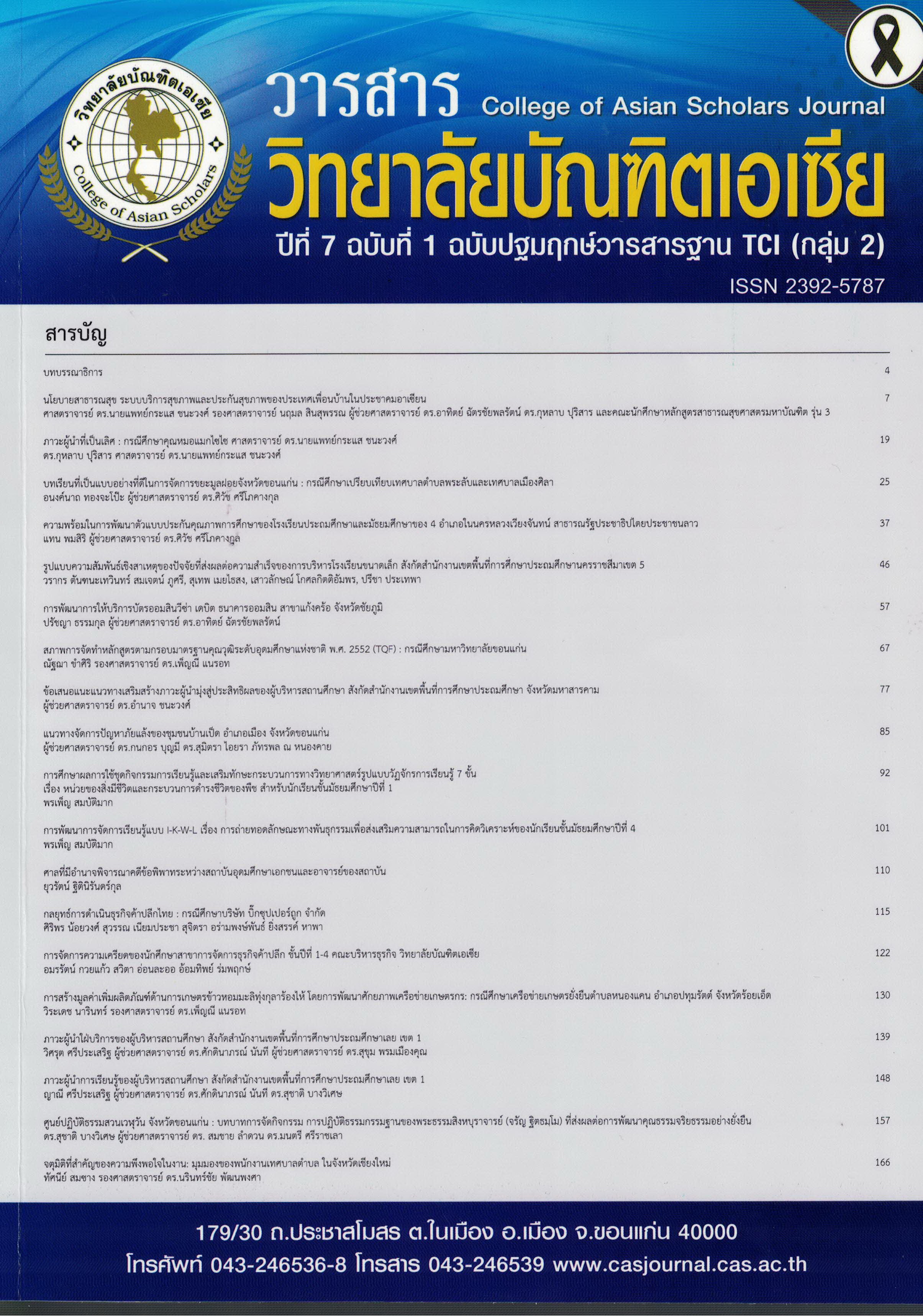ปีที่ 7
ฉบับที่ 1
เดือน มกราคม - มิถุนายน ปี พ.ศ. 2560
ไฟล์ ดาวน์โหลด |
1505124122-pp9.pdf |
|||||||||
|
ชื่อผู้วิจัย กนกอร บุญมี
|
|||||||||
| บทคัดย่อ ภาษาไทย | การศึกษาครั้งนี้มีวัตถุประสงค์ 2 ประการคือ 1) เพื่อศึกษาสภาพการจัดการปัญหาภัยแล้งของชุมชนบ้านเป็ด และ2) เพื่อนำเสนอแนวทางการจัดการปัญหาภัยแล้งของชุมชนบ้านเป็ด อำเภอเมือง จังหวัดขอนแก่น เป็นการวิจัยแบบผสมผสาน (Mixed Methods Research) เป็นการนำเอาวิธีการวิจัยทั้งเชิงปริมาณ (Quantitative Research) โดยใช้การสำรวจ สอบถามตัวแทนครัวเรือนชุมชนบ้านเป็ดจำนวน 400 ตัวอย่าง และใช้วิธีการวิจัยเชิงคุณภาพ (Quantitative Research) โดยใช้แบบสัมภาษณ์เชิงลึกผู้ใหญ่บ้าน ข้อมูลที่นำมาศึกษาได้มาจากแบบสอบถามและ แบบสัมภาษณ์การวิจัยที่มีคุณภาพ [ตรวจสอบความตรงจากผู้ทรงคุณวุฒิ 3 คน] ใช้การเลือกสุ่มแบบหลายขั้นตอน ผลการวิจัยสรุปได้ดังนี้ คือ 1) สภาพพื้นที่ของตำบลบ้านเป็ด ลักษณะภูมิประเทศโดยทั่วไปเป็นที่ราบสูง มีลำน้ำ ลำห้วย 1 แห่ง บึง หนอง และอื่น ๆ 11 แห่ง การจัดการปัญหาภัยแล้งของชุมชนบ้านเป็ด พบว่า การจัดการปัญหาภัยแล้งระยะสั้นของชุมชนที่ศึกษา 3 ด้าน มีระดับปฎิบัติมากทั้ง 3 ด้าน [ได้แก่ มีการรองน้ำฝนไว้ใช้ รับน้ำจากการแจกจ่าย และรับน้ำจากจุดบริการในหมู่บ้าน] การจัดการปัญหาภัยแล้งระยะยาวของชุมชนที่ศึกษา 3 ด้าน มีระดับปฎิบัติมากทั้ง 3 ด้าน [หมู่บ้านมีโครงการรณรงค์การใช้น้ำอย่างประหยัด มีโครงการการเพิ่มป่าและรักษาป่า และมีโครงการพัฒนาลุ่มน้ำ เช่น การสร้างฝาย เขื่อน ขุดหลอกแหล่งน้ำ] และ 3) แนวทางการแก้ปัญหาภัยแล้งของชุมชนบ้านเป็ด มี 2 แนวทาง ดังนี้ (1) ด้านการเตรียมการ มีการจัดทำบัญชีหมู่บ้านและชุมชนที่มีความเสี่ยงต่อการประสบปัญหาภัยแล้ง จัดทำแผนการดำเนินงานทั้งระบบอย่างชัดเจน เช่น แผนแจกจ่ายน้ำ การกำหนดจุดแจกจ่ายน้ำในแต่ละหมู่บ้าน (2) ด้านการเพาะปลูก จัดทำแผนและแนวทางการจัดการพืชผลการเกษตร และทำความเข้าใจให้เกษตรกรปลูกพืชที่ใช้น้ำน้อยหรือพืชฤดูแล้ง ประสานงานกับองค์กรที่เกี่ยวข้องเพื่อดูแลรักษาแหล่งน้ำสาธารณะ สถานที่เก็บกักน้ำ | |||||||||
| คำสำคัญ | ||||||||||
| บทคัดย่อ ภาษาอังกฤษ | The purposes of this research were : 1) to study the drought situation of Ban-ped community and 2) to present guidelines for drought management of Ban-ped community, Muang district, KhonKaen province. This research was mixed methods research.This research was application of quantitative research approach and qualitative research approach. The data were collected from400 questionnaires of household representatives in Ban-ped community and in-depth interviews with village headman. The data were collected from questionnaires and quality research interviews [checking validity by 3 experts] using multistage random sampling. The research results were as follows: 1) the area of Ban-ped sub-district was generally high plateau with 1 creek, 11 of marshes, lakes and others. The result of drought management of Ban-ped community was found that the short-term drought management of the community was rated at high level in three aspects[including reserving rainwater for using, receiving water from distribution and receiving water from service points in village]. The long-term drought management of the community was rated at high level in three aspects [the village had campaign project to use water economically, forestation project and forest conservation project and river basin development project like dike, dam and river excavation ]and 2)the guidelines for drought management of Ban-ped community consisted of two guidelines : (1) preparation, performing accounts of village and community at risks of drought, making a clear operation system plan such as water distribution plan, setting water distribution points in each village (2) planting, making guidelines for the management of agricultural crops and making understanding how farmers plant less water or drought crops, coordinating with related organization to maintain public water resources, water reservoirs. The purposes of this research were : 1) to study the drought situation of Ban-ped community and 2) to present guidelines for drought management of Ban-ped community, Muang district, KhonKaen province. This research was mixed methods research.This research was application of quantitative research approach and qualitative research approach. The data were collected from400 questionnaires of household representatives in Ban-ped community and in-depth interviews with village headman. The data were collected from questionnaires and quality research interviews [checking validity by 3 experts] using multistage random sampling. The research results were as follows: 1) the area of Ban-ped sub-district was generally high plateau with 1 creek, 11 of marshes, lakes and others. The result of drought management of Ban-ped community was found that the short-term drought management of the community was rated at high level in three aspects[including reserving rainwater for using, receiving water from distribution and receiving water from service points in village]. The long-term drought management of the community was rated at high level in three aspects [the village had campaign project to use water economically, forestation project and forest conservation project and river basin development project like dike, dam and river excavation ]and 2)the guidelines for drought management of Ban-ped community consisted of two guidelines : (1) preparation, performing accounts of village and community at risks of drought, making a clear operation system plan such as water distribution plan, setting water distribution points in each village (2) planting, making guidelines for the management of agricultural crops and making understanding how farmers plant less water or drought crops, coordinating with related organization to maintain public water resources, water reservoirs.
|
|||||||||
| Keyword | Drought, Guidelines for Drought Management | |||||||||
กนกอร บุญมี
1 บทความ| ชื่อ - สกุล | วารสาร | ไฟล์ |
หน้า |
|
|---|---|---|---|---|

|
กนกอร บุญมี CAS447 |
วารสารบัณฑิตเอเซีย |

.jpg)
.1.jpg)
1.jpg)
1.jpg)